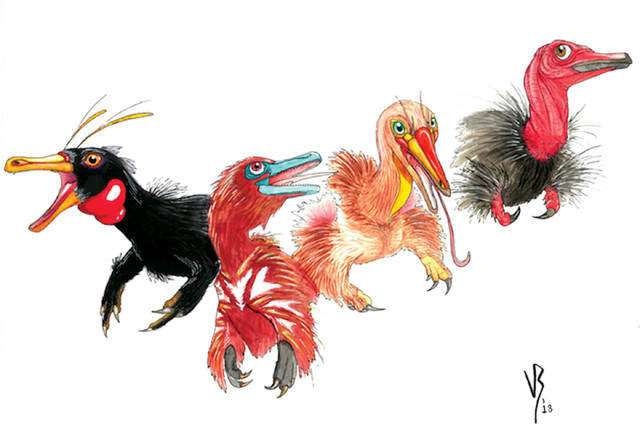
by Mary Caperton Morton Thursday, November 8, 2018

An artist's reconstruction of important alvarezsaurian genera from left to right: Haplocheirus, Xiyunykus, Bannykus and Shuvuuia. Credit: Viktor Radermacher.
Cretaceous rocks in northwestern China have yielded two new dinosaur species that help fill a 70-million-year gap in dinosaur phylogeny. The new species — Xiyunykus pengi and Bannykus wulatensis — are both alvarezsaurians, an odd group of dinosaurs that, by the Late Cretaceous, had evolved many avian characteristics such as birdlike skulls, tiny teeth and light, slender bodies, as well as unique mole-like single-clawed forearms that were likely useful for digging.
The earliest-known alvarezsaurian, Haplocheirus, which lived in the Late Jurassic and was first described in 1993, had longer arms, fully clawed hands and teeth characteristic of carnivores. The new species, which date to the Early Cretaceous, help explain how Late Jurassic alvarezsaurians evolved into more birdlike animals well adapted for digging.
The new specimens are morphologically and functionally intermediate between Haplocheirus and later alvarezsaurians, and “provide a striking example of the evolutionary transition from a typical theropod forelimb configuration to a highly specialized one,” wrote researchers led by paleontologist Xing Xu of the Chinese Academy of Sciences in Beijing, in Current Biology.
“It can be hard to pin down the relationships of highly specialized animals. But fossil species with transitional features, like Xiyunykus and Bannykus, are tremendously helpful because they link bizarre anatomical features to more typical ones,” said co-author Jonah Choiniere, of the University of the Witwatersrand in South Africa, in a statement.
© 2008-2021. All rights reserved. Any copying, redistribution or retransmission of any of the contents of this service without the expressed written permission of the American Geosciences Institute is expressly prohibited. Click here for all copyright requests.